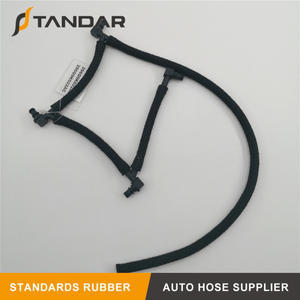- All
- Product Name
- Product Keyword
- Product Model
- Product Summary
- Product Description
- Multi Field Search
Views: 52 Author: Site Editor Publish Time: 2020-04-23 Origin: Site








The diesel leak off pipes connect the injector to the spill rail, which transports the excess fuel back to the fuel pump and the tank.
are small braided hoses that can wear down over time and draw air into the system. Thus, knowing how to use them properly is important, read the following article for more information.

What is the purpose of leak off pipes?
How should you deal with a leak off hose blow-by seat leak?
How do you service a diesel injector leak off pipe?
The fuel injector spill rail works many times per second. Leak-free seals with low tolerances are possible, but they will wear out very quickly. The key is to design for a greater sealing tolerance and manageable leakage. This applies not only to injectors but also to many hydraulic devices. Large tolerances reduce metal-to-metal contact, thereby reducing friction and reducing the sensitivity of the entire system to fretting and contamination, thereby extending service life and improving reliability. The problem was resolved when the leaking fluid was relayed back to the reservoir through a separate pipe.
Injector spill rail blowing is caused by one or more of the following symptoms. Difficult or difficult/uneven running/unstable ticking or idling/acceleration when producing black smoke or ticking around the injector/black tar (carbon). FUEL INJECTOR RAIL RETURN SPILL PIPE blowing is caused by the diesel engine injector seal not properly installed on the cylinder head. Sometimes you can repair the injector blow by removing the injector, cleaning the carbon in the injector and installing a new copper seal washer and reinstalling the injector. In some cases, this does not always correct the diesel leak off pipe blow due to seat erosion in the cylinder head being escaped by the combustion gas, resulting in seat damage. Fortunately, there is a seat cutting tool that can overcome this problem by gently refurbishing the seat.
Repairing return lines on diesel engines is something most ship owners can do with a few basic tools. This is particularly easy because it really just takes the injector out and takes it to the diesel plant. Actually, testing and rebuilding injectors requires specialized equipment and knowledge that most of us don't have.
The first technique is absolute, meticulous cleaning. When you take out the diesel leak off pipe, you expose the lungs of the engine; Any incoming contamination can cause serious damage. This threat is exacerbated by the fact that the Fuel Injector Return Hose is mounted in a deep hole in the engine cylinder head. When you remove the injector, dirt and debris will fall from the well into the cylinder. If the pollution is just a little bit of carbon, it will blow out the next time you start the engine, but if it's a shard of paint, or a scrap of metal, it can do real damage. So, before you do anything, check your entire engine with some clean rags and household spray cleaner to remove as much dust as possible. After that, release the store vac. This will remove dirt that the rag can't touch. After you remove the diesel leak off pipe, you also need to vacuum the injector well. To do this, if you don't have a proper cleaning attachment, you can attach small hoses to the end of your ordinary vacuum hose.
Once your engine is clean, turn off the fuel supply to the engine so that no fuel passes from the fuel distributor to the injector. Some may still drip out of the leaking pipe, as they are usually connected to the fuel supply and/or return lines, so be prepared to capture any leaks. The next step is to remove the feed lines and leak lines and seal them with plastic and tape to prevent dust from entering. After that, it's time to remove the diesel leak off pipe and it will be fastened to the engine or bolts or bolts and nuts.
If functioned properly, the injector return line hoses are a critical part of your diesel engine and can serve you a lot. For more technical support, contact our skilled technicians at any time.